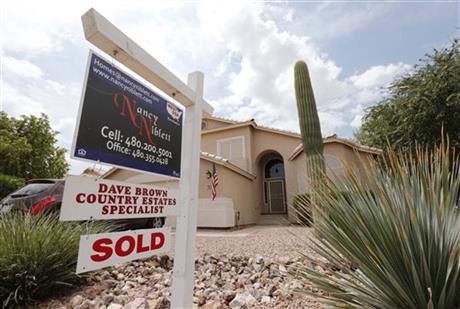
By MARCY GORDON
FILE – In this Thursday, Aug. 22, 2013, file photo, an existing home is listed as sold, in Gilbert, Ariz. Freddie Mac reports on mortgage rates for the second week of November on Thursday, Nov. 14, 2013. (AP Photo/Matt York, File)
WASHINGTON (AP) — Average U.S. rates on fixed mortgages rose for the second straight week amid some signs of economic strength. Still rates remain near historically low levels.
Mortgage buyer Freddie Mac said Thursday that the average rate on the 30-year loan increased to 4.35 percent from 4.16 percent last week. That’s the highest level since Sept. 19, when it was 4.50 percent. The average on the 15-year fixed mortgage rose to 3.35 percent from 3.27 percent. The rates, though, are at their lowest levels in four months.
A report from the government last week that U.S. employers added a surprisingly strong 204,000 jobs in October, despite the 16-day federal shutdown, indicated the economy may be sturdier than many had assumed.
Another government report showed surprising growth in the economy from July through September, though much of the gain came from a buildup in company stockpiles.
Mortgage rates began falling in September when the Federal Reserve continued its $85-billion-a-month bond purchases. The purchases are intended to keep long-term interest rates low.
Slower hiring in previous months had led many analysts to predict that the Fed will maintain the current pace of the bond purchases into early next year, likely keeping mortgage rates low for the immediate future.
Some economists saw comments Thursday by Fed Vice Chair Janet Yellen, nominated by President Barack Obama to be the next chairman of the central bank, as a sign that the Fed won’t move at its next meeting in December to reduce the bond purchases. Rather, the Fed could delay any so-called tapering of bond buying beyond March, when many have predicted it would begin.
Yellen told the Senate Banking Committee, which is considering her nomination, that the economy has regained ground lost to the Great Recession but still needs the Fed’s support because unemployment remains too high at 7.3 percent.
To calculate average mortgage rates, Freddie Mac surveys lenders across the country on Monday through Wednesday each week. The average doesn’t include extra fees, known as points, which most borrowers must pay to get the lowest rates. One point equals 1 percent of the loan amount.
The average fee for a 30-year mortgage slipped to 0.7 point from 0.8 point. The fee for a 15-year loan was unchanged at 0.7 point.
The average rate on a one-year adjustable-rate mortgage was steady at 2.61 percent. The fee declined to 0.4 point from 0.5 point.
The average rate on a five-year adjustable mortgage rose to 3.01 percent from 2.96 percent. The fee slipped to 0.4 point from 0.5 point.



